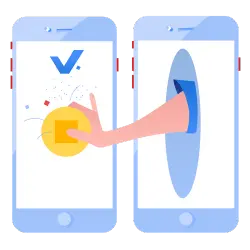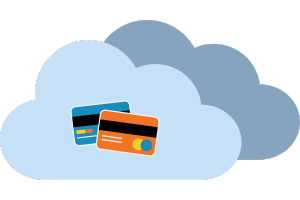TABLE OF CONTENTS
From mass corporations to small startups, businesses based in the US use ACH payments more now than ever before [1] NACHA. ACH Network Volume and Value Statistics. Accessed May 16, 2022. . Business owners can’t afford to fall behind in terms of one of the most lucrative payment methods across the US market. To combat this, merchants must understand how the ACH network operates as well as how to handle any ACH returns when they inevitably occur. Today, we’re breaking down ACH returns and taking a closer look at ACH return code R36: Improper Credit Entry.
What are ACH payments?

Automatic Clearing House (ACH) payments refer to a type of electronic bank-to-bank money transfer that operates in the United States. The ACH is the network that processes these specific payments.
To add greater ease, this billing technique is completely electronic. This means that a physical transaction does not occur at any point in the ACH transfer process. Funds deliver electronically from the debitor’s account to the creditor’s account. Therefore, associated banks or financial institutions involved in the transfer depend on where the businesses and customers do their banking. Remember, both parties don’t need to bank at the same institution to participate in an ACH transfer, making this payment method widely accepted.
What is an ACH Return?
ACH transfers seem pretty straightforward. However, ACH returns feel somewhat daunting to many merchants. An ACH return happens when funds aren’t able to be collected from the customer’s account. For additional assistance, the ACH network set guidelines that lay out the various reasons a transfer is eligible for a return. The network also determined a set of rules for the return process which depends on the reason behind each return.
ACH Return Codes
These ACH returns rely heavily on return codes. ACH return codes refer to the three-character messages that accompany an ACH return. The first character is always the letter ‘R,’ which stands for ‘return.’ Looking simply at this initial character tells the associated banks and merchant that a return was requested.
Each two-digit number works as a definition code for the cause of the return. Referencing the 85 return codes aids merchants in properly handling each return and ensuring a smooth ACH process for all involved parties.
ODFI
The Originating Depository Financial Institution (ODFI) is the bank or financial institution where an ACH payment originates. All ODFIs have a legal agreement with either The Clearing House or the Federal Reserve to operate under the ACH network. Financial Institutions may only conduct ACH transfers if they are already ODFI-approved. Most major banks hold ODFI approval. Additionally, payment processors, payment gateways, other financial institutions, and application programming interfaces (APIs) work as ODFIs if linked to an ACH operator.
RDFI
On the other side of the transaction is the RDFI. The Receiving Depository Financial Institution (RDFI) is the financial institution charged or refunded for an ACH payment. To be an RDFI, banks and other financial institutions must seek approval from an ACH operator (The Clearing House or Federal Reserve). Any financial institution or API must have RDFI approval to participate in ACH transfers on behalf of their customers.
What is the turnaround time for an ACH return?
In general, the turnaround time for ACH return codes consists of two banking days. However, this is not the rule for all ACH return codes. Depending upon the reason for the return, described by the specific return code, the turnaround time may vary. Simply put, some issues are harder to resolve than others and require additional time to correct the error. By taking a look at the specific return code, the merchant can better determine approximately how long the problem will persist and how long they will have to wait to receive their funds.
NACHA
For the ACH network to operate properly, there must be a governing body working as the authority on any regulations. This job falls to the National Automatic Clearing House Association (NACHA). NACHA operates as a supervisor to the entire ACH network. The association designed all of the current 85 return codes. NACHA standardized these codes across industries. By doing so, businesses, banks, processing services, and other financial institutions involved in ACH transfers utilize the same return codes. ACH payment users refer to the NACHA-provided ACH return codes for definitions and specific guidelines for a resolution regarding each specific return code.
What Does ACH Return Code R36 Mean?
Return code R36 is a less commonly occurring ACH return code. ACH return code R36 occurs when the bank initiates a return due to improper credit entry. ACH transfers do not permit the use of credit entries with ARC, BOC, POP, RCK, TEL, and XCK payment formats. There is an exception to this rule in the case of reversing entries.
Formal definition
ACH return code R36 stands for ‘Return of improper Credit Entry.’
Solutions to Fix R36 Return Code

ACH return code R36 occurs in both consumer and non-consumer accounts. The typical timeframe regarding a resolution to this code depends on the next file delivery time following the ACH return’s processing. Unfortunately, merchants cannot resolve this return code on their own. Both associated banking institutions must handle the return process. It is up to them to solve the issue regarding improper credit entry and hopefully complete the transfer.
If the dispute causes additional issues, such as a delay in delivery of products or services to your customer, politely inform the customer of the current problem. Assure the customer that the associated banks know about and are working to resolve the issue. If your customer requires expedited delivery of the items or services, offer an alternative payment method.
Final Thoughts
With 85 unique ACH return codes to learn, ACH returns may feel overwhelming. However, our list of codes will help you resolve any return codes you may encounter. Check out PaymentCloud’s resources for more on accepting ACH payments.





